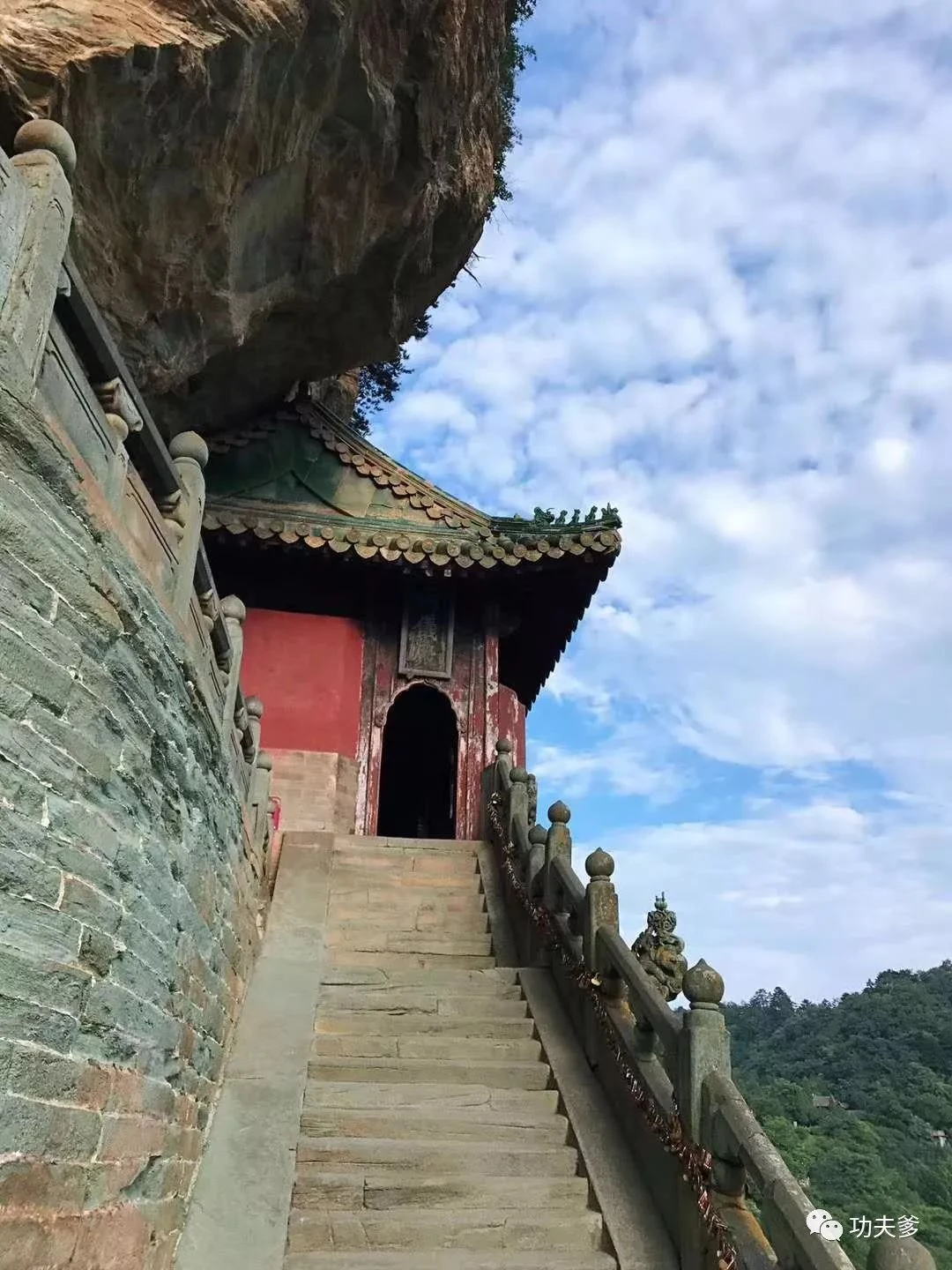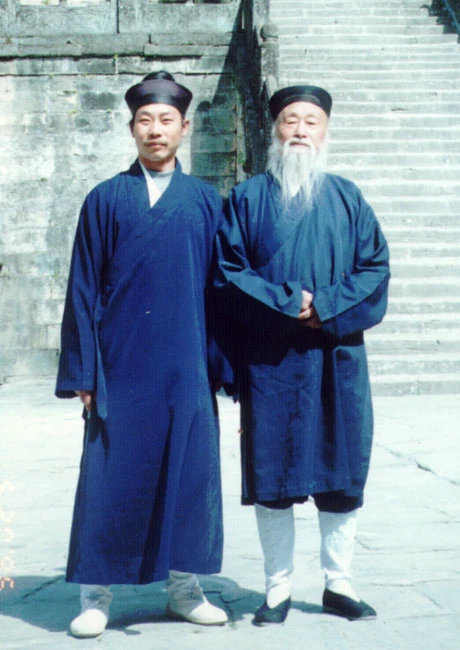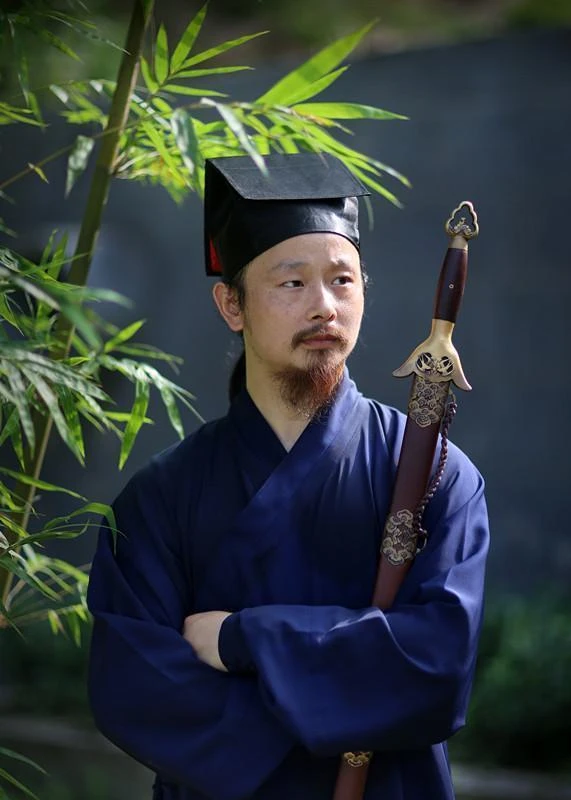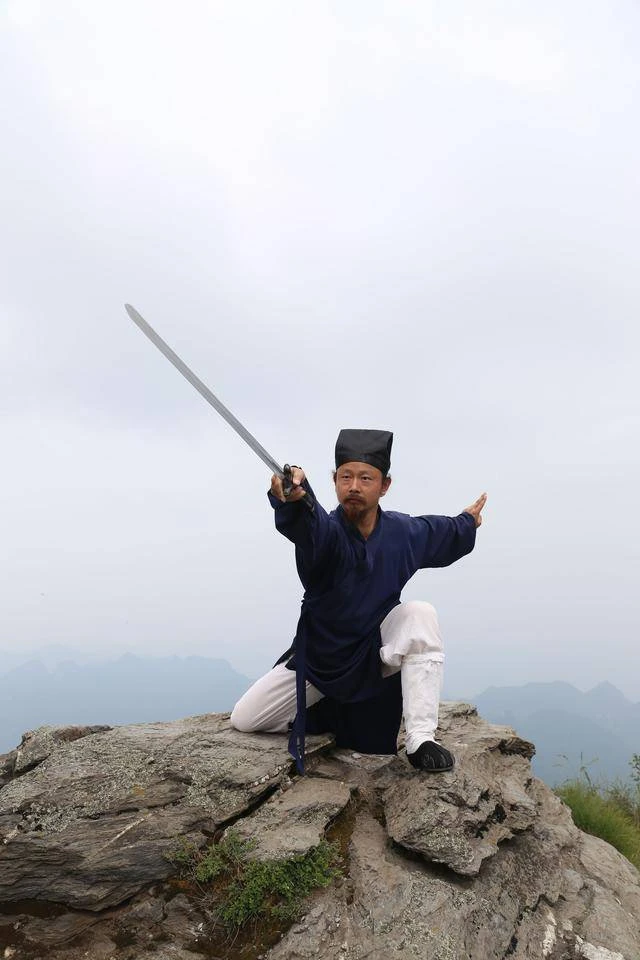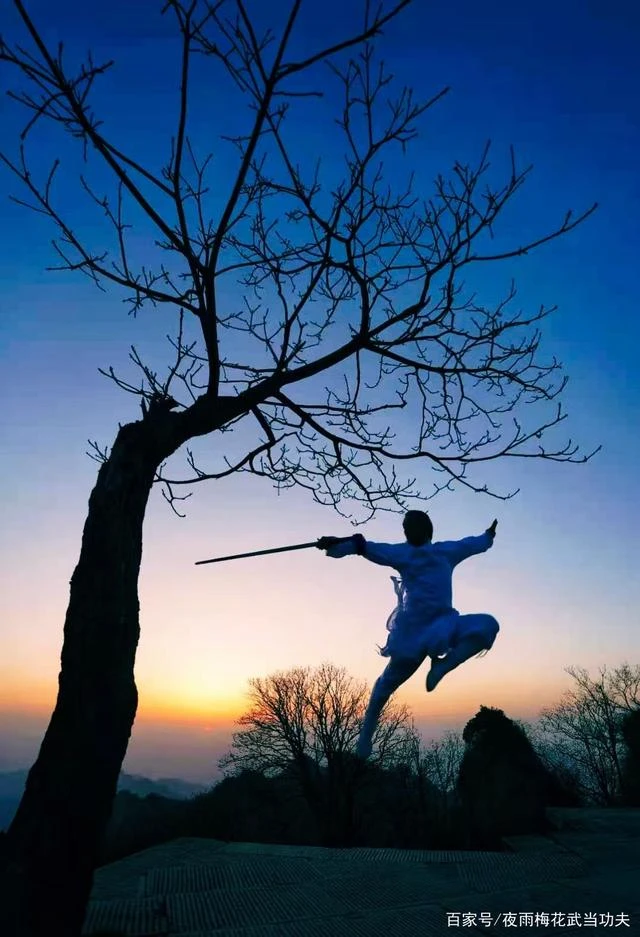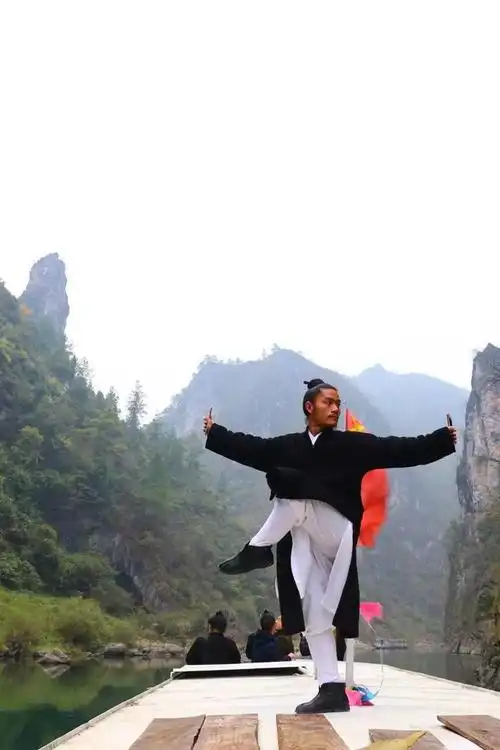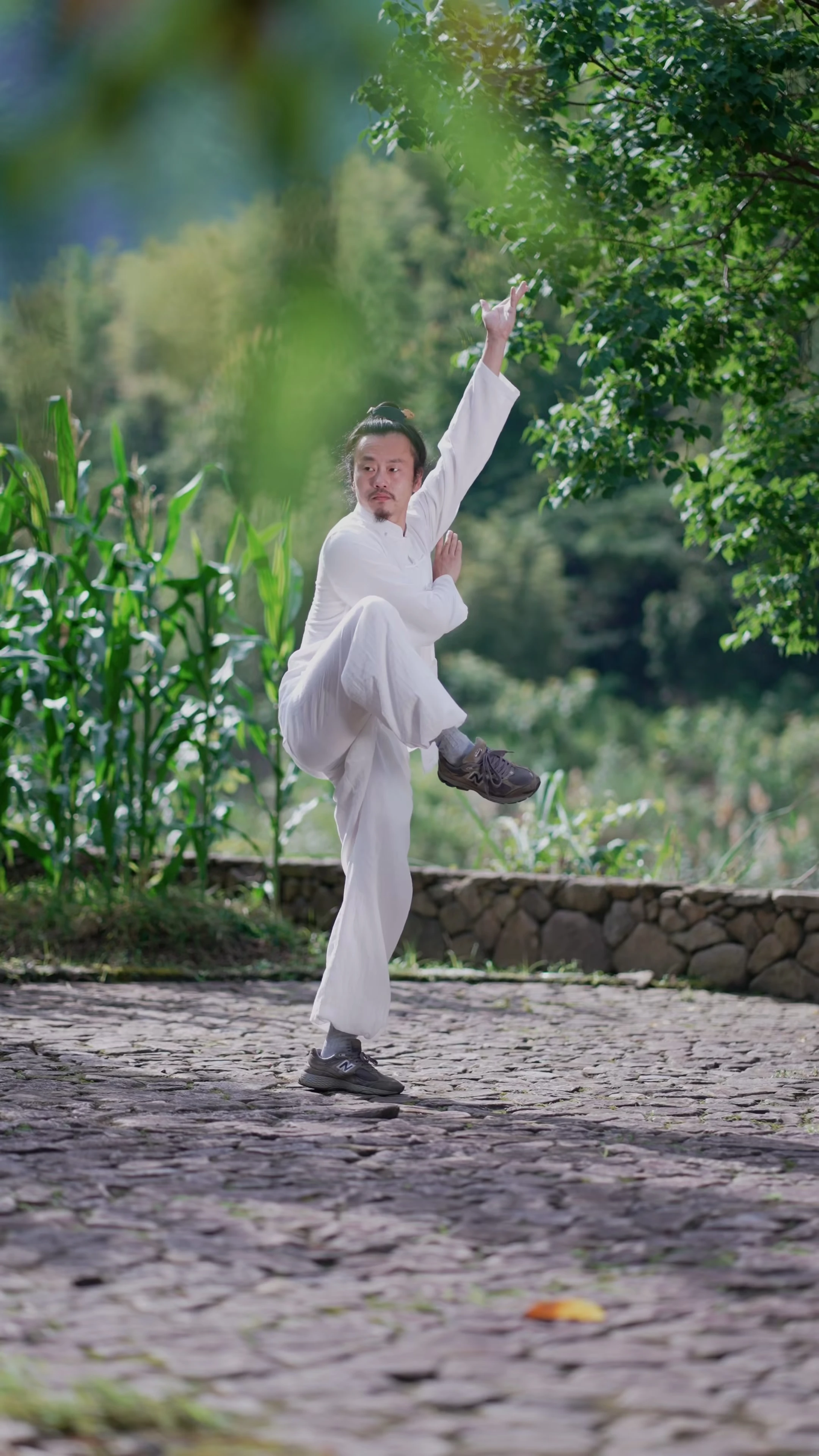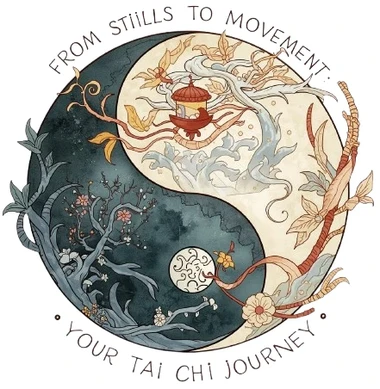The Core of Wudang Kung Fu: It’s Not What You Think
Hey there, fellow martial arts enthusiast.
Let me guess: when you think of Kung Fu, you picture high-flying kicks, powerful punches, and shattered bricks, right? That’s the Shaolin way, and it’s incredible.
But what if I told you there’s a whole other side to Chinese martial arts? One that’s more about internal power than external strength? Welcome to the world of Wudang Kung Fu.
My name is Mike Sang, and through my journey with Tai Chi Wuji, I’ve come to see Wudang not just as a fighting style, but as a moving philosophy. It’s a system designed not only for self-defense but for forging a resilient, calm, and powerful self. So, what exactly is the core of this ancient art?
Wudang vs. Shaolin: What's the Real Difference?
Before we dive deep, let's clear up the biggest confusion. People often ask us at Tai Chi Wuji: "Should I learn Shaolin or Wudang?" It's like asking if you should be a sprinter or a marathon runner. Both are athletes, but their training and goals are worlds apart.
Think of it this way:
| Feature | Wudang (The Internal School) | Shaolin (The External School) |
|---|
| Philosophy | Taoist: Yield, absorb, and redirect. Flow like water. | Buddhist: Direct, powerful, and overwhelming. Strike like fire. |
| Focus | Cultivating internal energy (Qi), sensitivity, and mind-body connection. | Building muscular strength, bone density, and physical conditioning. |
| Movement | Soft, continuous, circular, and often slower to develop precision. | Hard, explosive, linear, and fast to develop speed and power. |
| Primary Power | From the "dantian" (core) and whole-body connection (整劲, Zhěng jìn). | From the limbs and muscular contraction. |
| End Goal | Self-mastery, longevity, and harmony. | Peak physical performance and combat effectiveness. |
Neither is "better." They are just different paths up the same mountain. But if your interest lies in the art of using an opponent's force against them, and in a practice that heals as it strengthens, then Wudang is your path.
The Secret Sauce: It’s All in the "Silk Reeling"
Okay, so Wudang is "internal." What does that feel like? The answer lies in a concept we drill daily at Tai Chi Wuji: "Chán Sī Jìn" (缠丝劲), or "Silk Reeling Energy."
This isn't some mystical magic. It's a very specific mechanical principle.
Imagine trying to pull a single silk thread from a cocoon. If you yank it hard, it snaps. You have to be gentle, consistent, and spiral your finger to guide it out in an unbroken, coiling motion. That’s the essence.
In physical terms, Silk Reeling Energy is the spiraling, coiling, and uncoiling motion that originates from the dantian (your center of gravity, just below the navel) and travels through the body's fascia and connective tissues to the limbs. It’s not a localized arm or leg movement.
Here’s a secret from my own practice: When you move with this spiraling energy, you’re not just using muscles. You’re engaging your entire body as one unified structure. This is what allows a 120-pound Wudang master to uproot a 200-pound attacker. It’s not about overpowering; it's about redirecting force through optimal structure and movement.
More Than Fighting: The Three Pillars of Wudang Practice
This internal mechanics stuff is cool, but Wudang Kung Fu is a complete system for life. At its heart, it rests on three inseparable pillars:
- Combat & Self-Defense: Yes, it’s effective. The iconic Tai Chi Chuan is often misunderstood as just slow-motion exercise. In reality, every gentle circle is a practical application—a block, a joint lock, a throw. Styles like Xingyiquan (Form-Intent Fist) are more direct and explosive, while Baguazhang (Eight Trigram Palm) uses constant circling and evasive footwork to disorient opponents. It's a full toolbox.
- Health & Longevity: This is non-negotiable. The internal exercises, like Zhan Zhuang (Standing Meditation) and Qigong, are designed to regulate your breath, calm your nervous system, and promote the smooth flow of Qi and blood. The slow, controlled movements of Tai Chi are like giving your internal organs a gentle, therapeutic massage. It’s why studies now link it to improved balance, lower blood pressure, and reduced stress.
- Mind & Spirit Cultivation: This is the glue that holds it all together. Wudang is a moving meditation. The intense focus required to coordinate breath, movement, and intention forces you into the present moment. It trains your mind to be as calm and responsive in a conflict as it is in a quiet practice session. The Taoist principles of balance (Yin-Yang) and non-contention (Wu Wei) become lived experiences, not just philosophical ideas.
So, What's the Takeaway?
Wudang Kung Fu isn't just an alternative way to fight. It's an alternative way to move, to think, and to live. It’s a lifelong journey of discovering the power that comes from softness, the speed that comes from slowness, and the strength that comes from inner peace.
Does the idea of cultivating this kind of deep, intelligent power resonate with you? Are you curious to feel what "Silk Reeling Energy" is like in your own body?
This is just the beginning of the conversation. We've only scratched the surface of what Wudang has to offer. Over at the Tai Chi Wuji community forum, we're constantly breaking down these concepts, sharing training tips, and helping each other on this path. We’d love to hear your thoughts and questions.
What aspect of Wudang Kung Fu are you most curious about? Is it the practicality for self-defense, the health benefits, or the philosophical side? Let us know in the comments on our site!
Ready to feel the difference between external force and internal power? Explore our beginner-friendly guides and join a community of passionate learners at Tai Chi Wuji. The journey inward starts with a single step.
From Myth to Modernity: The Living History of Wudang
So, how did this incredible art form come to be? The story of Wudang is as layered and fascinating as its techniques, blending myth, history, and a relentless human spirit.
A Legend is Born: The Sage and the Snake
Let's start with the good stuff—the legend. Every great art needs a great origin story, and Wudang's is a classic.
The tale goes that the Song Dynasty sage, Zhang Sanfeng, watched a crane and a snake in a deadly duel. The crane, with its sharp beak and powerful wings, attacked relentlessly. But the snake didn't meet force with force. It yielded, coiled, and spiraled, effortlessly dodging every strike and waiting for the perfect moment to counter-attack.
In that moment, Zhang had an epiphany. Softness could conquer hardness. Yielding could overcome force. It was a revolution in combat philosophy. He realized that true power wasn't about being stronger, but about being smarter and more adaptable. This, they say, was the birth of the core principles of Wudang Kung Fu and Tai Chi.
Now, is this story a historical fact? Well, it's the founding myth that has inspired generations. It perfectly encapsulates the art's soul. It tells us that Wudang wasn't invented in a battlefield charge, but in a moment of quiet, Taoist observation of nature.
The Keepers of the Flame: A Secretive Lineage
For centuries, Wudang Kung Fu was a closely guarded secret, passed down selectively within the Taoist monasteries on the mist-shrouded Wudang Mountain. It wasn't for show; it was for spiritual cultivation and self-defense.
But legends need champions. Figures like Zhang Songxi in the Ming Dynasty became folk heroes, their exploits cementing Wudang's reputation in the martial world. However, the 20th century brought challenges. Wars and social upheaval threatened to sever these ancient threads.
This is where the real-life heroes of modern Wudang emerge. Elder masters like Zhu Chengde and Guo Gaoyi, who had kept the traditions alive in secret, began to cautiously share their knowledge. Then came a pivotal generation, like Zhong Yunlong. These were practitioners who not only learned the old ways but had the vision to bring them out of the temple and into the world.
The Modern Revolution: Wudang Goes Global
This is the part of the story that gets me most excited, because it's the one we're all a part of today. Masters like Zhong Yunlong did something radical: they opened schools. They created performance troupes. They started saying "yes" to students from around the globe.
They were followed by a new wave of practitioners like Chen Shixing, whose incredible lightness skill videos took the internet by storm, and Yuan Shimao, who dedicated himself to international teaching.
They used new tools to showcase an ancient art, proving that Wudang was not a dead relic, but a living, breathing, and explosively dynamic practice.
Why This History Matters to YOU
You might wonder, "Why do I need to know about old masters?" Here's the Tai Chi Wuji perspective: When you learn Wudang, you're not just learning a set of movements. You're stepping into a river of knowledge that has been flowing for centuries.
You're connecting your personal journey to that of the sage on the mountain, the lone master preserving the art through hard times, and the modern pioneer sharing it with the world.
Understanding this lineage adds a layer of depth and respect to every posture you hold and every breath you take. It transforms your practice from a workout into a conversation with history.
The Taoist Engine: Philosophy in Motion
Alright, let's get practical. You might be thinking, "Yin and Yang, Wu Wei... it sounds great on a poster, but what does it actually do in a fight?" This is where Wudang Kung Fu separates itself from mere exercise. The philosophy isn't just a nice idea; it's a practical, tactical operating system.
"Using Softness to Overcome Hardness" Isn't a Platitude—It's a Physics Equation.
The core principle of "Yǐ Róu Kè Gāng" (以柔克刚) is often misunderstood as being passive. It's not. It's hyper-active intelligence. Think of it this way: if a strong, fast punch is coming at your face, you have two basic options:
- The "Hard" Way: Block it with your own arm. This is a contest of strength. You win if your arm is stronger than their punch. You lose if it's not. Either way, it hurts.
- The "Soft" Wudang Way: You don't meet the force head-on. You intercept it, "listen" to its direction and power (a skill we call Tīng Jìn, 听劲), and then you join it. You might redirect it with a circular parry, or you might yield and let it pass harmlessly by turning your body, unbalancing your opponent in the process.
It's not about being weak. It's about being like a willow tree in a storm. The rigid oak tree snaps, but the willow bends, absorbs the energy, and remains unbroken. At Tai Chi Wuji, we call this "strategic yielding." You're not running away; you're making their strength useless and, even better, turning it against them.
The Power of "Non-Action" in the Middle of a Fight
This leads us to the most mind-bending concept: "Wú Wéi" (无为). It doesn't mean "doing nothing." It means "effortless action" or "action that doesn't interfere with the natural flow."
How on earth do you apply that in combat? Let me give you an example from Push Hands (Tuishou), the two-person training drill that is the laboratory for all these ideas.
When you're in a Push Hands exchange, a beginner's mind is frantic: "I need to push him! I need to resist! I need to win!" This tension and striving make you rigid and predictable.
The Wudang way, the Wu Wei way, is different. You stay relaxed and centered. You don't initiate the conflict; you respond to it. You become a mirror. If your partner pushes, you don't push back. You absorb, neutralize, and reflect their energy back at them. The action comes not from your own aggressive plan, but as a natural, effortless response to their action. Their attack creates the very opening that leads to their defeat.
It feels like magic when you first experience it. You're not muscling your way to victory; you're simply following the path of least resistance that your opponent has so kindly provided for you.
This is why we tell our students: 'The calmer you are, the more powerful you become.' It's counter-intuitive, but it's the heart of the internal arts.
Yin and Yang: The Ultimate Balancing Act
You see Yin and Yang on everything from T-shirts to yoga mats. In Wudang, it's a dynamic, physical reality. Every movement contains its opposite.
- When you punch (Yang), it is born from a relaxed, rooted, and yielding (Yin) state.
- When you retreat (Yin), you are gathering energy and intention (Yang) for the next movement.
- Your rooted, stable feet (Yin) provide the foundation for the expressive, mobile hands (Yang).
There's no pure Yin or pure Yang. There's only the continuous, flowing interplay between them. This is why Wudang forms look so fluid and graceful—they are a physical manifestation of this eternal dance.
Let's get interactive for a second. Think about your own training, in any discipline. Can you find a moment of "Yin and Yang"? Maybe it's the inhalation and exhalation during a weightlifting rep, or the coiled crouch before a basketball jump shot. Share your "Aha!" moment with us in the Tai Chi Wuji forum—we geek out over this stuff!
This philosophical engine—Softness, Wu Wei, and Balance—is what makes Wudang Kung Fu so much more than fighting. It becomes a framework for life.
How do you handle a stressful deadline? Do you fight it rigidly, or can you yield, adapt, and find a fluid solution? The lessons on the training ground are lessons for the world.
The Wudang Toolbox: Your Map to the Inner Arts System
So, we've covered the mind and the history. Now, let's get to the good stuff: the tools. If Wudang Kung Fu is a vehicle for self-mastery, then these are the engines, the steering, and the navigation system. It's a vast and sophisticated toolkit, and knowing where to start can be the biggest challenge.
First Things First: Building Your Internal Power Plant (Neigong)
Before any flashy kicks or punches, we start with the foundation: Neigong (内功), or "internal skill." Think of this as building the engine that will power everything else. If you skip this, you're just dancing.
- What it is: A series of static and dynamic exercises designed to cultivate, circulate, and store your body's intrinsic energy (Qi).
- The Crown Jewel: Zhan Zhuang (站桩 - Standing Post). Don't let its simplicity fool you. Standing perfectly still, arms rounded as if hugging a giant tree, is one of the most demanding and rewarding practices. From a Tai Chi Wuji coach's logbook: "The first five minutes are a battle with your own mind. Then, the chatter fades. You feel the weight sink into your feet, the spine elongates, and a deep, warm vibration starts to hum in your core. That's your system 'booting up'—it's the birth of true internal power."
- The Science Behind It: This isn't just mystical talk. Modern bio-mechanics and fascia research support this. You're optimizing your body's structure, releasing chronic tension, and enhancing neural connectivity. It's the ultimate reset button for a body wrecked by modern, sedentary life.
The Three Pillars of Wudang Fist Arts
Once you've begun charging your internal battery, you channel that energy into movement. The three most famous Wudang fist systems are a masterclass in tactical diversity.
Taijiquan (太极拳 - Supreme Ultimate Fist): The Art of Flow.
- The Vibe: Slow, continuous, and graceful. It looks like a meditative dance.
- The Reality: It's a highly sophisticated close-quarters combat and grappling system. Every single "slow-motion" movement has a practical application. That gentle push? It's a joint lock. That circular parry? It's a throw.
- Our Take: Tai Chi is often sold as only health exercise. While it's phenomenal for that, at its heart, it's a defensive martial art for the patient strategist.
Xingyiquan (形意拳 - Form-Intent Fist): The Art of the Straight Line.
- The Vibe: Direct, explosive, and linear. It's powerful and no-nonsense.
- The Reality: Xingyi is built on the Five Elements (Wood, Fire, Earth, Metal, Water), each corresponding to a specific attacking angle and energy. It teaches you to generate devastating power over the shortest possible distance, like a cannonball.
- Our Take: If Tai Chi is like flowing water, Xingyi is like a crashing wave. It's the perfect counter-balance for those who find Tai Chi 'too soft,' teaching direct, penetrating power.
Baguazhang (八卦掌 - Eight Trigram Palm): The Art of Deception.
- The Vibe: Constant circling, spiraling, and rapid changes of direction. It's hypnotic and disorienting to watch.
- The Reality: Bagua fighters are never where you think they are. They use intricate footwork to "walk the circle," evading attacks and appearing at your blind spot to strike or unbalance you.
- Our Take: Bagua is for the tactical, agile mind. It's the ultimate expression of 'using the soft to overcome the hard' through mobility and misdirection.
Beyond Empty Hands: The Soul of Wudang Weapons
Weapons training in Wudang isn't an add-on; it's an extension of your body and energy.
- The Jian (剑 - Double-Edged Sword): The "Gentleman of Weapons." Wielding the Jian isn't about brute force. It's about finesse, precision, and agility. The practice refines your whole-body coordination to an incredible degree. The signature "swinging" and "shaking" movements of the Wudang Jian are a direct application of Silk Reeling Energy.
- The Gun (棍 - Staff): The Foundation. The long staff is where you learn power generation and leverage. It teaches you how to project energy to the very tip of a weapon, a skill that translates directly back to your empty-hand power.
- The Fuchen (拂尘 - Horsetail Whisk): The Unconventional. Once a Taoist ritual object, the Fuchen is a unique and flexible weapon. Its whipping, entangling movements are unpredictable and incredibly difficult to defend against, embodying the Wudang principle of softness.
So, where do YOU start in this vast system?
It's the question we get most at Tai Chi Wuji. The answer is personal, but a great path for most is:
Standing Post (Zhan Zhuang) -> Foundational Qigong -> Tai Chi 13 Postures or 18 Form.
This sequence builds your energy, teaches you the core principles, and gives you a manageable, complete form to practice, all while laying the groundwork for a lifetime of exploration.
Your Secret Weapon for Modern Life: Why Wudang is the Antidote to the 21st Century
Let's be real. You're probably not planning to fend off a band of outlaws on a mountain path. Your daily battles look different: looming deadlines, endless notifications, a body that aches from too much sitting, and a mind that just won't shut off.
What if I told you that a 600-year-old Taoist art holds the key to winning these modern wars? Here’s how Wudang Kung Fu becomes your most unexpected and powerful ally.
Fight "Sitting Disease" with Taoist Movement
Your body was designed to move, not to be chained to a chair. The result? Tight hips, a weak core, stiff shoulders, and chronic pain.
The Wudang Fix: Forget frantic, high-impact workouts that pound your already stressed joints. Wudang is all about low-impact, holistic movement. The slow, controlled motions of Tai Chi, combined with deep, diaphragmatic breathing, are like a full-body tune-up.
A Simple Exercise You Can Try Now: The "Wudang Desk Release" (based on Cloud Hands):
- Sit or stand tall. Imagine your head being pulled up by a string.
- Inhale, and gently float one hand up in front of your chest, palm facing you.
- Exhale, and let that hand sink down as the other floats up, as if your hands are gently moving through water.
- Let your waist turn slightly with the movement. Feel the rotation in your spine.
Why it works: This simple, 60-second break counters the static forward hunch, mobilizes your spine and shoulders, and forces you to breathe deeply, instantly reducing physical and mental tension.
Rewire Your Brain: The Moving Meditation for Stress
Your brain is constantly bombarded. The result? Anxiety, brain fog, and that feeling of being "always on."
- The Wudang Fix: Wudang practice is meditation in motion. You cannot perform the complex, coordinated patterns of a form while worrying about your inbox. You are forced into the present moment. This is a trained, practical form of mindfulness.
- The Science Says: Studies consistently show that practices like Tai Chi lower cortisol (the stress hormone), improve mood, and enhance cognitive function. As we often say at Tai Chi Wuji, 'A distracted mind is a weak mind. A focused mind is your greatest strength.' You're not just learning to fight; you're learning to focus.
Find Your Tribe: More Than a Gym, It's a Community
In a world of digital connections, deep, real-world community is rare. The gym can be a lonely place.
- The Wudang Fix: Traditionally, your training partners are your "Kung Fu brothers and sisters" (同门, Tóngmén). You learn together, struggle together, and grow together. The practice of Push Hands (Tuishou) teaches you trust, sensitivity, and non-verbal communication. It's a conversation without words.
- Beyond the Training Hall: This sense of belonging is transformative. It’s a support network that celebrates your progress and helps you through plateaus. This is why we built the Tai Chi Wuji forum—to create a global Tóngmén community, where you're never training alone.
Let's Get Personal: What's Your Biggest Challenge?
We've talked about physical stress, mental clutter, and loneliness. But your journey is unique.
We want to hear from you. Head over to the Tai Chi Wuji forum and tell us: What is the single biggest health or life challenge you're facing right now?
Is it:
- A nagging lower back pain that won't quit?
- The inability to switch off your brain at night?
- Feeling disconnected and lacking a sense of purpose?
- Just wanting to feel strong and confident in your own body?
Share your story. Our community and coaches are there to offer insights, share experiences, and perhaps show you how a specific Wudang principle or practice could be your key to unlocking that challenge. This isn't just about us teaching you; it's about us learning how to serve you better.
Wudang Kung Fu isn't an escape from modern life. It's a toolkit for thriving within it. It equips you with the calm, the resilience, and the vitality not just to survive your day, but to master it.
Your Journey Begins Now
So, here we are. We've traveled from the misty peaks of Wudang, through the profound depths of Taoist philosophy, and right into the heart of your modern life. You've seen that Wudang Kung Fu isn't a relic; it's a living, breathing system for building a more capable, calm, and resilient you.
Let's be clear about what this really is.
This isn't about learning to break boards. It's about breaking habits—the habit of tension, the habit of reactive stress, the habit of feeling disconnected from your own body and potential. It's about replacing the noise in your head with a profound sense of focus, and replacing weakness with a power that comes from your very core.
The path of Wudang is a journey of self-discovery. Every time you practice standing post, you're not just standing—you're building an unshakable foundation.
Every time you flow through a Tai Chi form, you're not just moving—you're learning the art of graceful adaptation. Every time you practice Push Hands, you're not just sparring—you're mastering the skill of listening, yielding, and responding intelligently to the pressures of life.
You don't need to become a monk on a mountain to start. You just need to take the first step.
That first step is the most important one. And it can be incredibly simple.
Here at Tai Chi Wuji, we've built a bridge between this ancient art and your modern life. We've stripped away the mystery and preserved the power, creating a clear path for you to begin.
Your invitation is waiting. Here’s how you start, today:
- Dive Deeper with Our Community: This conversation doesn't have to end here. Join our Tai Chi Wuji Forum. It’s a thriving space where beginners and seasoned practitioners alike share their struggles, breakthroughs, and questions. Post your story from Part 5. Tell us what you're curious about. Our community and coaches are ready to welcome you. This is your new Tóngmén, your global kung fu family.
- Find Your First Lesson: Ready to feel the difference between muscle and internal power? Explore our structured, beginner-friendly online courses. We guide you step-by-step, starting with the fundamentals of Zhan Zhuang and Qigong, all the way to learning the beautiful and potent Wudang 18 Form. Your journey is mapped out for you.
You have a choice. You can continue with the same routines, the same stressors, the same frustrations. Or, you can choose a different path. You can choose to cultivate a strength that doesn't fade with age, a calm that can't be shaken by chaos, and a community that supports your growth.
The ancient masters laid the path. Modern pioneers brought it to the world. Now, it's your turn.
Your journey toward inner power, health, and harmony begins with a single, intentional step.
Take that step. Visit us at
https://www.taichiwuji.com/ and transform your practice from a dream into your daily reality. We can't wait to train with you.
Frequently Asked Questions About Wudang Kung Fu
What exactly is Wudang Kung Fu and how is it different from Shaolin?
Wudang Kung Fu is a system of internal Chinese martial arts rooted in Taoist philosophy. While Shaolin focuses on external strength, speed, and power, Wudang emphasizes internal energy (Qi), softness, and using an opponent's force against them. Think of it as the strategic, "soft" counterpart to Shaolin's "hard" style.
Is Wudang Kung Fu effective for real self-defense?
Absolutely. While its slow-motion forms like Tai Chi are famous for health, they are, at their core, sophisticated combat systems. Wudang techniques specialize in close-range grappling, joint locks, throws, and redirection, making them highly effective for practical self-defense without relying on brute strength.
I'm not flexible or in great shape. Can I still learn Wudang Kung Fu?
Yes! Wudang is uniquely accessible. The training is designed to meet you where you are. It builds flexibility, strength, and coordination gradually from the inside out. The initial focus is on posture, breathing, and foundational energy work (Qigong), making it perfect for beginners of all fitness levels.
What are the main health benefits of practicing Wudang Kung Fu?
The benefits are extensive and backed by growing scientific evidence. They include: Reduced Stress & Anxiety: The moving meditation calms the nervous system. Improved Balance & Coordination: This significantly reduces the risk of falls, especially in older adults. Joint Health & Pain Relief: Low-impact movements lubricate joints and ease chronic pain (e.g., back pain). Enhanced Cardiovascular Health: Improves circulation and blood pressure. Sharper Mental Focus: Requires and builds deep mind-body connection.
Who was Zhang Sanfeng and did he really create Wudang Kung Fu?
Zhang Sanfeng is the legendary Taoist sage credited with founding Wudang Kung Fu. While historical details are blended with myth, the core story of him observing a crane and a snake and realizing the principle of "softness overcoming hardness" defines the art's philosophy. He is considered the spiritual and technical patriarch.
What's the difference between Wudang Tai Chi and the Tai Chi I see in parks?
Many "park style" Tai Chi classes focus almost exclusively on the health aspects. Traditional Wudang Tai Chi preserves the complete art, including its martial applications, internal power development (Neigong), and deeper philosophical context. It's the same root, but Wudang training often provides a more holistic and combat-ready system.
How long does it take to become proficient in Wudang Kung Fu?
Wudang is a lifelong journey, but meaningful benefits start immediately. Within a few months of consistent practice, you'll feel tangible improvements in relaxation, balance, and energy levels. Developing a strong foundation in core principles and a basic form can take 1-2 years of dedicated practice. The depth of the art ensures there is always more to learn and refine.
What should a complete Wudang training session include?
A balanced session typically follows this structure: Warm-up & Joint Mobilization: Gentle stretching to prepare the body. Qigong (Energy Work): Standing meditation (Zhan Zhuang) and dynamic exercises to cultivate Qi. Basics & Foundation: Drilling stances, steps, and core mechanics like "Silk Reeling Energy." Form Practice: Performing a solo sequence (e.g., Tai Chi 18 Form). Application & Partner Work: Practicing techniques with a partner through exercises like Push Hands (Tuishou). Cool-down & Meditation: Integrating the practice and calming the mind.
Can I learn Wudang Kung Fu online, or do I need a teacher in person?
You can make significant progress with high-quality online instruction, especially for learning the basic forms and concepts. This is the foundation of what we offer at Tai Chi Wuji. However, for deeper correction, understanding subtle energies, and advanced partner work, periodic guidance from a qualified instructor—whether in person or through virtual private sessions—is invaluable.
What is 'Silk Reeling Energy' (Chan Si Jin) and why is it so important?
Silk Reeling Energy is the fundamental coiling and uncoiling power that is the hallmark of internal arts. It's a spiraling motion that starts from the core and extends through the limbs, creating a connected, whip-like power. It's crucial because it allows you to generate tremendous force without muscular tension, making your movement both powerful and efficient. It’s the physical manifestation of the Taoist principle of circularity.
